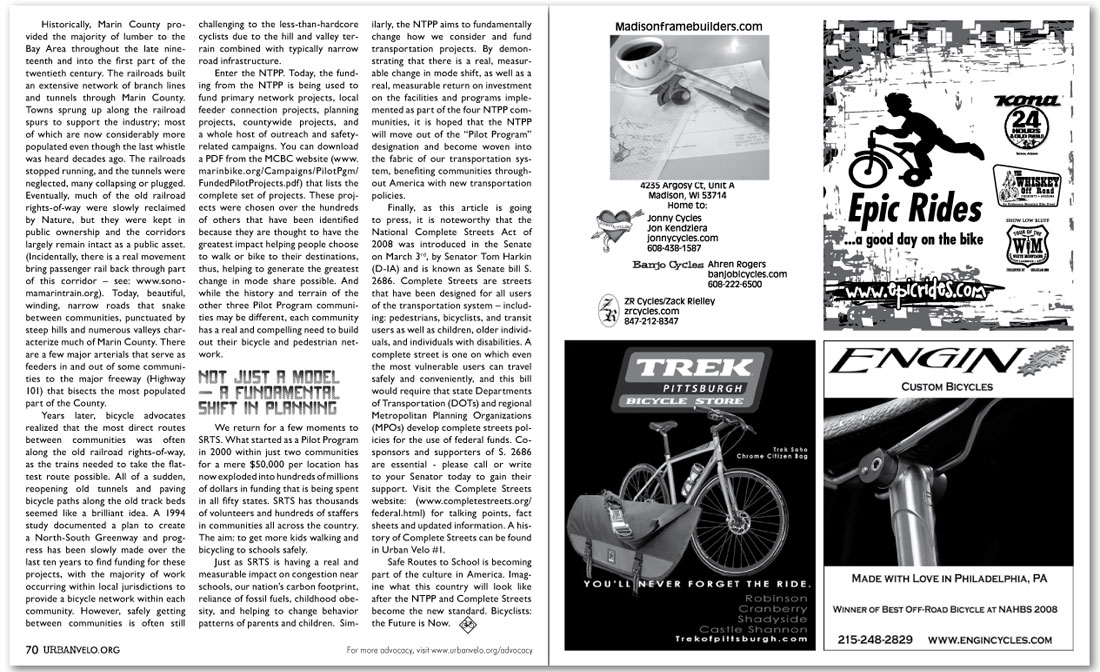Historically, Marin County provided the majority of lumber to the Bay Area throughout the late nineteenth and into the first part of the twentieth century. The railroads built an extensive network of branch lines and tunnels through Marin County. Towns sprung up along the railroad spurs to support the industry; most of which are now considerably more populated even though the last whistle was heard decades ago. The railroads stopped running, and the tunnels were neglected, many collapsing or plugged. Eventually, much of the old railroad rights-of-way were slowly reclaimed by Nature, but they were kept in public ownership and the corridors largely remain intact as a public asset. (Incidentally, there is a real movement bring passenger rail back through part of this corridor – see: www.sonomamarintrain.org). Today, beautiful, winding, narrow roads that snake between communities, punctuated by steep hills and numerous valleys characterize much of Marin County. There are a few major arterials that serve as feeders in and out of some communities to the major freeway (Highway 101) that bisects the most populated part of the County.
Years later, bicycle advocates realized that the most direct routes between communities was often along the old railroad rights-of-way, as the trains needed to take the flattest route possible. All of a sudden, reopening old tunnels and paving bicycle paths along the old track beds seemed like a brilliant idea. A 1994 study documented a plan to create a North-South Greenway and progress has been slowly made over the last ten years to find funding for these projects, with the majority of work occurring within local jurisdictions to provide a bicycle network within each community. However, safely getting between communities is often still challenging to the less-than-hardcore cyclists due to the hill and valley terrain combined with typically narrow road infrastructure.
Enter the NTPP. Today, the funding from the NTPP is being used to fund primary network projects, local feeder connection projects, planning projects, countywide projects, and a whole host of outreach and safety-related campaigns. You can download a PDF from the MCBC website (www.marinbike.org/Campaigns/PilotPgm/FundedPilotProjects.pdf) that lists the complete set of projects. These projects were chosen over the hundreds of others that have been identified because they are thought to have the greatest impact helping people choose to walk or bike to their destinations, thus, helping to generate the greatest change in mode share possible. And while the history and terrain of the other three Pilot Program communities may be different, each community has a real and compelling need to build out their bicycle and pedestrian network.
Not Just A Model - A Fundamental Shift in Planning
We return for a few moments to SRTS. What started as a Pilot Program in 2000 within just two communities for a mere $50,000 per location has now exploded into hundreds of millions of dollars in funding that is being spent in all fifty states. SRTS has thousands of volunteers and hundreds of staffers in communities all across the country. The aim: to get more kids walking and bicycling to schools safely.
Just as SRTS is having a real and measurable impact on congestion near schools, our nation’s carbon footprint, reliance of fossil fuels, childhood obesity, and helping to change behavior patterns of parents and children. Similarly, the NTPP aims to fundamentally change how we consider and fund transportation projects. By demonstrating that there is a real, measurable change in mode shift, as well as a real, measurable return on investment on the facilities and programs implemented as part of the four NTPP communities, it is hoped that the NTPP will move out of the “Pilot Program” designation and become woven into the fabric of our transportation system, benefiting communities throughout America with new transportation policies.
Finally, as this article is going to press, it is noteworthy that the National Complete Streets Act of 2008 was introduced in the Senate on March 3rd, by Senator Tom Harkin (D-IA) and is known as Senate bill S. 2686. Complete Streets are streets that have been designed for all users of the transportation system – including: pedestrians, bicyclists, and transit users as well as children, older individuals, and individuals with disabilities. A complete street is one on which even the most vulnerable users can travel safely and conveniently, and this bill would require that state Departments of Transportation (DOTs) and regional Metropolitan Planning Organizations (MPOs) develop complete streets policies for the use of federal funds. Co-sponsors and supporters of S. 2686 are essential - please call or write to your Senator today to gain their support. Visit the Complete Streets website: (www.completestreets.org/federal.html) for talking points, fact sheets and updated information. A history of Complete Streets can be found in Urban Velo #1.
Safe Routes to School is becoming part of the culture in America. Imagine what this country will look like after the NTPP and Complete Streets become the new standard. Bicyclists: the Future is Now.
